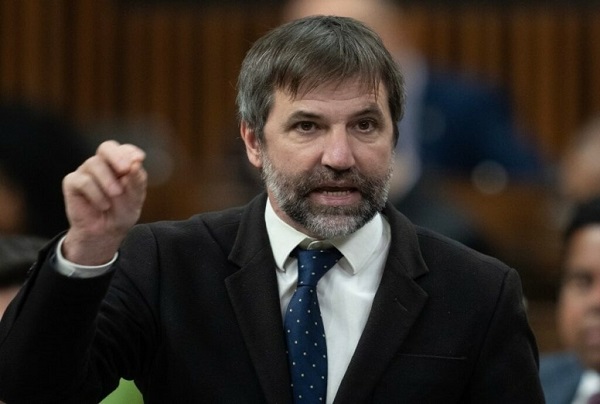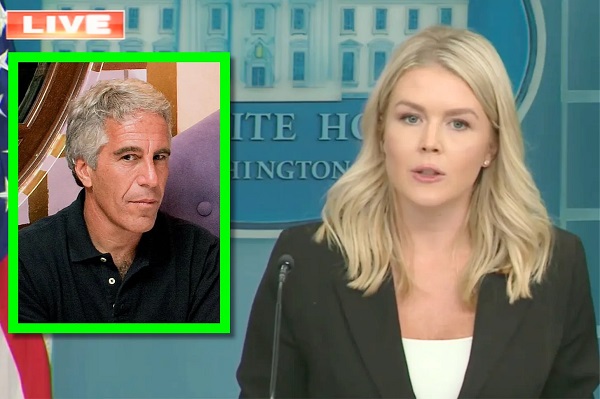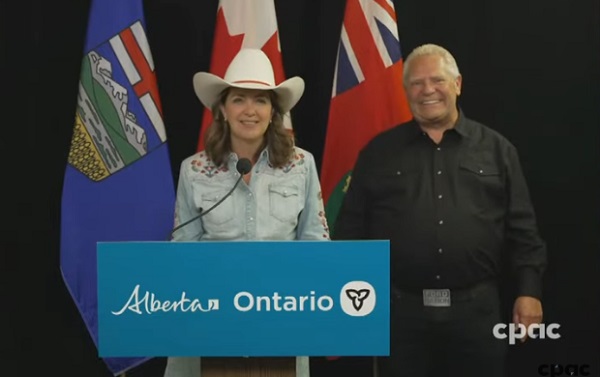Economy
The Cost to Western Canada if Steven Guilbeault Copies Biden’s Assault on LNG

From EnergyNow.ca
By Jim Warren
” if all of the gas exported by Canada to the US from 2014 to 2021, the years encompassing the price depression, had instead been exported to Europe at average European prices, Canadian natural gas revenues would have been US $100.7 billion higher “
What would it cost western Canada’s natural gas producers if the federal government does to them what it did to tidewater export opportunities for petroleum?
This question became topical last week when the Biden Democrats announced they would block construction of new LNG export facilities in the US. It makes sense to get a handle on the size of revenues at stake if future development of LNG export capacity in Canada is similarly at risk. Indeed, it seems quite reasonable to worry that Steven Guilbeault will take inspiration from the Biden decision and try to do something similarly silly in Canada.
Getting pipelines to tidewater is something Canada’s petroleum industry has been counting on to improve export revenues. This was a particularly urgent hope during the eight-year oil price depression that lasted from Fall 2014 until early Winter 2022. It was, and still is, assumed exporting Canadian diluted bitumen (dilbit) into new non-US markets will allow producers to avoid the costly differential charges assessed by American buyers and refiners.
What if scenarios floated during the eight-year price slump showed that had the Northern Gateway and Trans Mountain pipelines been completed, Canadian producers could have earned billions in additional revenues. Estimates of lost revenues ranged from a Fraser Institute estimate of $15.8 billion for 2018 alone to my own low-ball estimate for losses of $7 billion to $9 billion for that same year. Numerous back of the napkin “what if” calculations for lost revenues produced in coffee shops across the prairies helped fuel frustration and anger at federal government environmental policies intended to limit global warming by cancelling pipelines.
Fast forward to 2024 and we can see that similar conditions apply to western Canada’s natural gas sector. The US is virtually the sole export market for Canadian natural gas. Looking back at the period from 2010-2019 we find that the prices paid by US importers for Canadian natural gas were less than half what Europeans were paying. The price spread became exponentially wider beginning in 2016. It peaked in 2022 when the European price was six times higher than the US price. The European gas price will be five times higher than US prices for 2024.
All else being equal, if all of the gas exported by Canada to the US from 2014 to 2021, the years encompassing the price depression, had instead been exported to Europe at average European prices, Canadian natural gas revenues would have been US $100.7 billion higher than what they actually were.
Of course “all else” is far from being equal. The $100.7 billion figure does not account for the cost of converting natural gas to LNG or the added costs of ocean transportation. In addition, the estimate assumes enough Canadian pipelines and tidewater terminals could be built to accommodate all of the gas currently flowing to the US.
The yawning chasm between US and EU prices today is of course largely the result of Russia’s invasion of Ukraine in late February 2022. EU sanctions aimed at Russian energy exports and the destruction of the Nord Stream pipelines has put Europe firmly on track for developing new sources of natural gas.
Notwithstanding the bland platitudes and unreachable targets emanating from the most recent COP conference in the UAE, there are policy makers in many countries who recognize the important role natural gas can play in reducing global GHG emissions. For example, in December 2021 the European Commission made changes to its GHG emissions law. It now allows both nuclear energy and natural gas to be considered suitable transition fuels during the period while renewable options become more viable.
Lately, there has been a popular backlash in Europe and the UK over excessively zealous green transition initiatives. It turns out a lot of people are unwilling to accept additional increases to their cost of living even when told it is necessary to “save the planet.” People won’t stand for a prohibitively expensive green transition. And they never will be willing to freeze in the dark; especially when an acceptable option like natural gas is available.
Biden’s bizarre decision to block the expansion of US LNG export facilities was probably not motivated by a desperate desire or useful effort to curb GHG emissions. It is more likely a ham-handed attempt to staunch the Democrats’ loss of support among the young and the woke. Regardless of Biden’s motivation, we might reasonably worry that Canada’s environment minister will want to copy him. You might think the collapse in support for Canada’s Liberals and common sense would militate against the imposition of any additional half-baked environmental policy. But when has common sense ever intervened in the creation of environmentally virtuous policy on the part of the Liberals in Ottawa?
I have provided my data sources and relevant tables below
Hypothetical question: What if the exports to the US had been exported to Europe?

Source: derived by the author from the sources and data provided below
Natural gas prices for the US and Europe 2022 to 2024 in US$ per million British thermal units (BTUs) 2023 and 2024 figures are forecasts.*

Source: derived from Statist: Natual gas commodity prices in Europe and the United States from 1980 to 2022 with forecasts for 2023 and 2024.
https://www-statista-com.libproxy.uregina.ca/statistics/252791/natural-gas-prices/
Canadian natural gas exports in billion cubic metres (all to US)

Source: Statista. Natural gas exports by pipeline from Canada from 2010 to 2021 (in billion cubic metres).
https://www-statista-com.libproxy.uregina.ca/statistics/567703/natural-gas-exports-from-canada/
Natural gas prices for the US and Europe 2010 to 2024 in US$ per million British thermal units (BTUs) 2023 and 2024 figures are forecasts.*

Source: Statista: Natural gas commodity prices in Europe and the United States from 1980 to 2022 with forecasts for 2023 and 2024.
https://www-statista-com.libproxy.uregina.ca/statistics/252791/natural-gas-prices/
Automotive
Federal government should swiftly axe foolish EV mandate

From the Fraser Institute
Two recent events exemplify the fundamental irrationality that is Canada’s electric vehicle (EV) policy.
First, the Carney government re-committed to Justin Trudeau’s EV transition mandate that by 2035 all (that’s 100 per cent) of new car sales in Canada consist of “zero emission vehicles” including battery EVs, plug-in hybrid EVs and fuel-cell powered vehicles (which are virtually non-existent in today’s market). This policy has been a foolish idea since inception. The mass of car-buyers in Canada showed little desire to buy them in 2022, when the government announced the plan, and they still don’t want them.
Second, President Trump’s “Big Beautiful” budget bill has slashed taxpayer subsidies for buying new and used EVs, ended federal support for EV charging stations, and limited the ability of states to use fuel standards to force EVs onto the sales lot. Of course, Canada should not craft policy to simply match U.S. policy, but in light of policy changes south of the border Canadian policymakers would be wise to give their own EV policies a rethink.
And in this case, a rethink—that is, scrapping Ottawa’s mandate—would only benefit most Canadians. Indeed, most Canadians disapprove of the mandate; most do not want to buy EVs; most can’t afford to buy EVs (which are more expensive than traditional internal combustion vehicles and more expensive to insure and repair); and if they do manage to swing the cost of an EV, most will likely find it difficult to find public charging stations.
Also, consider this. Globally, the mining sector likely lacks the ability to keep up with the supply of metals needed to produce EVs and satisfy government mandates like we have in Canada, potentially further driving up production costs and ultimately sticker prices.
Finally, if you’re worried about losing the climate and environmental benefits of an EV transition, you should, well, not worry that much. The benefits of vehicle electrification for climate/environmental risk reduction have been oversold. In some circumstances EVs can help reduce GHG emissions—in others, they can make them worse. It depends on the fuel used to generate electricity used to charge them. And EVs have environmental negatives of their own—their fancy tires cause a lot of fine particulate pollution, one of the more harmful types of air pollution that can affect our health. And when they burst into flames (which they do with disturbing regularity) they spew toxic metals and plastics into the air with abandon.
So, to sum up in point form. Prime Minister Carney’s government has re-upped its commitment to the Trudeau-era 2035 EV mandate even while Canadians have shown for years that most don’t want to buy them. EVs don’t provide meaningful environmental benefits. They represent the worst of public policy (picking winning or losing technologies in mass markets). They are unjust (tax-robbing people who can’t afford them to subsidize those who can). And taxpayer-funded “investments” in EVs and EV-battery technology will likely be wasted in light of the diminishing U.S. market for Canadian EV tech.
If ever there was a policy so justifiably axed on its failed merits, it’s Ottawa’s EV mandate. Hopefully, the pragmatists we’ve heard much about since Carney’s election victory will acknowledge EV reality.
Economy
The stars are aligning for a new pipeline to the West Coast

From Resource Works
Mark Carney says another pipeline is “highly likely”, and that welcome news.
While attending this year’s Calgary Stampede, Prime Minister Mark Carney made it official that a new pipeline to Canada’s West Coast is “highly likely.”
While far from a guarantee, it is still great news for Canada and our energy industry. After years of projects being put on hold or cancelled, things are coming together at the perfect time for truly nation-building enterprises.
Carney’s comments at Stampede have been preceded by a number of other promising signs.
At a June meeting between Carney and the premiers in Saskatoon, Alberta Premier Danielle Smith proposed a “grand bargain” that would include a privately funded pipeline capable of moving a million barrels of oil a day, along with significant green investments.
Carney agreed with Smith’s plan, saying that Canada needed to balance economic growth with environmental responsibility.
Business and political leaders have been mostly united in calling for the federal government to speed up the building of pipelines, for economic and strategic reasons. As we know, it is very difficult to find consensus in Canada, with British Columbia Premier David Eby still reluctant to commit to another pipeline on the coast of the province.
Alberta has been actively encouraging support from the private sector to fund a new pipeline that would fulfil the goals of the Northern Gateway project, a pipeline proposed in 2008 but snuffed out by a hail of regulations under former Prime Minister Justin Trudeau.
We are in a new era, however, and we at Resource Works remarked that last month’s G7 meeting in Kananaskis could prove to be a pivotal moment in the history of Canadian energy. An Ipsos poll found that Canada was the most favoured nation for supplying oil in the G7, and our potential as an energy superpower has never been more important for the democratic world, given the instability caused by Russia and other autocratic energy powers.
Because of this shifting, uncertain global climate, Canadian oil and gas are more attractive than ever, and diversifying our exports beyond the United States has become a necessity in the wake of Donald Trump’s regime of tariffs on Canada and other friendly countries.
It has jolted Canadian political leaders into action, and the premiers are all on board with strengthening our economic independence and trade diversification, even if not all agree on what that should look like.
Two premiers who have found common ground are Danielle Smith and Ontario Premier Doug Ford. After meeting at Stampede, the pair signed two memorandums of understanding to collaborate on studying an energy corridor and other infrastructure to boost interprovincial trade. This included the possibility of an eastward-bound pipeline to Ontario ports for shipping abroad.
Ford explicitly said that “the days of relying on the United States 100 percent, those days are over.” That’s in line with Alberta’s push for new pipeline routes, especially to northwestern B.C., which are supported by Smith’s government.
On June 10, Resource Works founder and CEO Stewart Muir wrote that Canadian energy projects are a daunting endeavour, akin to a complicated jigsaw puzzle, but that getting discouraged by the complexity causes us to lose sight of the picture itself. He asserted that Canadians have to accept that messiness, not avoid it.
Prime Minister Carney has suggested he will make adjustments to existing regulations and controversial legislation like Bill C-69 and the emissions cap, all of which have slowed the development of new energy infrastructure.
This moment of alignment between Ottawa, the provinces, and other stakeholders cannot be wasted. The stars are aligning, and it will be a tragedy if we cannot take a great step into the future of our country.
-

 Bruce Dowbiggin2 days ago
Bruce Dowbiggin2 days agoEau Canada! Join Us In An Inclusive New National Anthem
-

 Crime2 days ago
Crime2 days agoEyebrows Raise as Karoline Leavitt Answers Tough Questions About Epstein
-

 Alberta2 days ago
Alberta2 days agoCOWBOY UP! Pierre Poilievre Promises to Fight for Oil and Gas, a Stronger Military and the Interests of Western Canada
-

 Alberta2 days ago
Alberta2 days agoAlberta and Ontario sign agreements to drive oil and gas pipelines, energy corridors, and repeal investment blocking federal policies
-

 Crime1 day ago
Crime1 day ago“This is a total fucking disaster”
-

 International2 days ago
International2 days agoChicago suburb purchases childhood home of Pope Leo XIV
-

 Fraser Institute1 day ago
Fraser Institute1 day agoBefore Trudeau average annual immigration was 617,800. Under Trudeau number skyrocketted to 1.4 million annually
-

 Daily Caller2 days ago
Daily Caller2 days agoBlackouts Coming If America Continues With Biden-Era Green Frenzy, Trump Admin Warns





